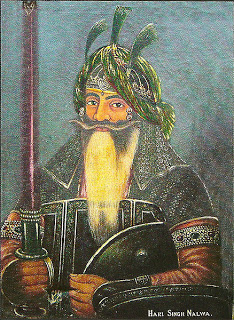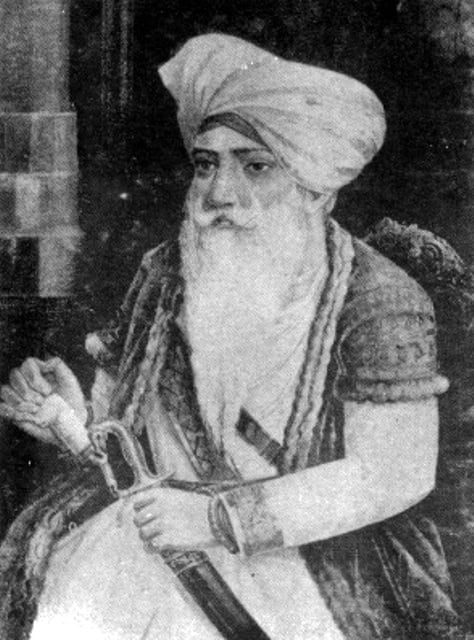Hari Singh Nalwa Age, Death, Caste, Wife, Family, Biography & More
Quick Info→
Age: 46 Years
Marital Status: Married
Hometown: Gujranwala, Pakistan
| Bio/Wiki | |
|---|---|
| Profession | Commander-in-chief of the Sikh Khalsa Fauj |
| Personal Life | |
| Date of Birth | 29 April 1791 (Friday) |
| Birthplace | Gujranwala, Sukerchakia Misl in the Majha region of Punjab |
| Date of Death | 30 April 1837 |
| Place of Death | Jamrud, Pakistan |
| Age (at the time of death) | 46 Years |
| Death Cause | Hari Singh Nalwa died after being grievously wounded in the Battle of Jamrud (1837) |
| Zodiac sign | Taurus |
| Nationality | Indian |
| Hometown | Gujranwala, in the Majha region of Punjab |
| Religion/Religious Views | Sikhism Note: Hari Singh Nalwa took Amrit Sanchar at the age of ten |
| Caste | According to historians, Hari Singh Nalwa belonged to a Khatri family from the Uppal clan, hailing from Majitha town near Amritsar. |
| Relationships & More | |
| Marital Status (at the time of death) | Married |
| Family | |
| Wife/Spouse | • Raj Kaur (from Rawalpindi) • Desan Kaur |
| Children | He had four sons and two daughters. |
| Parents | Father- Gurdial Singh Uppal Mother- Dharam Kaur |
Some Lesser Known Facts About Hari Singh Nalwa
- Hari Singh Nalwa (1791–1837) was a Sikh warrior who served as Commander-in-chief of the Sikh Khalsa Fauj, the military force of the Sikh Empire from 1804 to 1837. He played a key role in the conquests of Kasur, Sialkot, Attock, Multan, Kashmir, Peshawar, and Jamrud and is credited with expanding the Sikh Empire’s borders from the Indus River to the entrance of the Khyber Pass. Apart from that, Hari Singh Nalwa served as the Governor of Kashmir, Peshawar, and Hazara. To simplify revenue collection in Kashmir and Peshawar, he established a mint on behalf of the Sikh Empire.
- He was seven when his father passed away. Thereafter, he was raised by his mother.
- Nalwa was just 12 when he began managing his father’s estate and started learning horse riding.
- His father and grandfather were also great warriors and fought in many wars. In 1762, his grandfather, Hardas Singh, fought against the great warrior Ahmad Shah Durrani.
- At the age of fourteen, Hari Singh Nalwa became associated with Ranjit Singh, the first Maharaja of the Sikh Empire when his mother sent him to the Maharaja’s court to to settle a property dispute. During this meeting, Nalwa disclosed that his father and grandfather had served under Maha Singh and Charat Singh, ancestors of Maharaja Ranjit Singh. Demonstrating his skills as a horseman and musketeer, Nalwa impressed Ranjit Singh, who ruled in Nalwa’s favour and extended an offer for him to serve as a personal attendant at the court.

- Around 1804, Nalwa faced a tiger attack during a hunt that resulted in the death of his horse. Despite offers of assistance from fellow hunters, Nalwa declined and purportedly single-handedly killed the tiger using a dagger. This remarkable feat led to him being dubbed “Baghmar,” translating to Tiger-killer. Since then, he came to be known as ‘Baaghmaar’ (aka Tiger Killer).
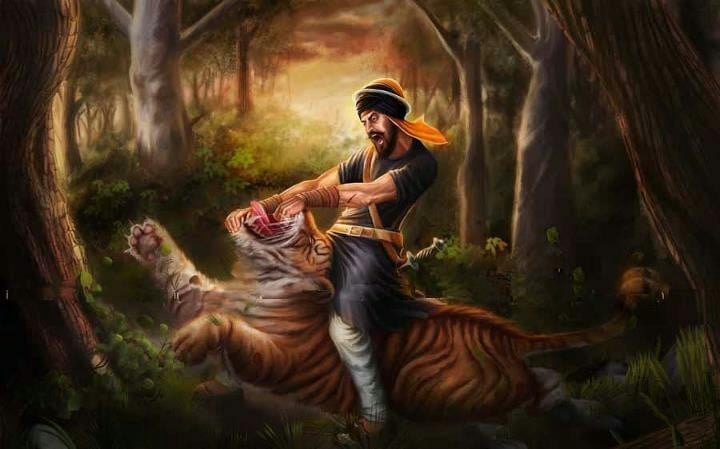
- In that same year, Nalwa received a commission as a Sardar in Maharaja Ranjit Singh’s army, commanding 800 horses and footmen.
- In 1807, Hari Singh started playing a pivotal role in the Sikh conquest when he took charge of an independent contingent during the capture of Kasur. Situated near Maharaja Ranjit Singh’s capital, Lahore, Kasur had long been a troublesome place and was captured in the fourth attempt. The attack was led by Maharaja Ranjit Singh and Jodh Singh Ramgarhia. Hari Singh demonstrated remarkable courage and expertise throughout the capture, which earned him a “Jagir” as a reward for his services.
- During the Siege of Multan (1807), Ranjit Singh did not defeat his enemies all at once. He wanted to avoid excessive bloodshed and tried to weaken them slowly. Ranjit Singh made seven attempts to conquer Multan, and Hari Singh Nalwa participated in five of those battles. On the way to Multan, they seized Dilalpur and Jhang. The Sikhs surrounded the Multan Fort but with the help of Fateh Singh Kaliawalia, a peaceful resolution was reached. The Maharaja lifted the siege with a lot of money.
- Ranjit Singh selected Hari Singh Nalwa to conquer Sialkot from its leader, Jiwan Singh. This became Nalwa’s first battle, where he commanded independently. The two armies clashed for a few days, and ultimately, seventeen-year-old Hari Singh emerged victorious. Nalwa successfully led the army and hoisted the Sikh Flag on the fort.
- Ranjit Singh’s army captured Sialkot in 1808. Thereafter, Hari Singh Nalwa led Sikhs to invade Jammu. Ranjit Singh’s instructions to Nalwa were to take control of the nearby regions of Jammu. Nalwa successfully conquered the city with the help of a Sikh named Hukam Singh Chimni.
- In 1810, Hari Singh Nalwa attacked Multan again. Ranjit Singh had told Muzaffar Khan to give tribute, but he refused. So, the Sikhs laid siege to Multan once again. In the fight, Hari Singh Nalwa got badly hurt when someone threw a firepot at him while climbing the fort. Muzaffar Khan asked the British for help, but they didn’t join him. Eventually, after a two-month-long siege, Muzaffar Khan had to give up. After that, he paid Rs 180,000 to Sikhs and gave them 20 horses as tribute.
- The Attock fort held great significance for any army crossing the Indus River, serving as a point where armies restocked supplies. In the early 19th century, Afghans, appointed by the Kingdom of Kabul, controlled this fort and much of the surrounding land. In 1813, Dewan Mokham Chand, a general under Maharaja Ranjit Singh, led the Sikhs in the Battle of Attock and won. The battle was fought on the banks of the Indus against Wazir Fatteh Khan and Dost Mohammad Khan, who represented Shah Mahmud of Kabul. In addition to Hari Singh Nalwa, other key participants included Hukam Singh Attariwala, Shyamu Singh, Khalsa Fateh Singh Ahluwalia, and Behmam Singh Malliawala. Following the capture of Attock, the Sikhs gained control over neighbouring regions like Hazara-i-Karlugh and Gandhgarh. In 1815, Sherbaz Khan of Gandhgarh challenged Hari Singh Nalwa’s authority and was defeated.
- After the Battle of Attock, the Sikhs aimed to conquer Kashmir. Maharaja Ranjit Singh led the army, establishing a camp at Rajauri. Ram Dayal, the grandson of Dewan Mokham Chand, led the troops toward Srinagar. The front was commanded by Jamadar Khushal Singh, with Hari Singh Nalwa and Nihal Singh Attariwala positioned at the back. Challenges such as a lack of food, delayed reinforcements, adverse weather, and betrayal by allies compelled the Sikhs to retreat. In the subsequent years, their focus shifted to suppressing Muslim leaders in the Kashmir region as they advanced towards the Srinagar Valley. In 1815–16, Hari Singh Nalwa attacked and destroyed the stronghold of the treacherous chief of Rajauri.
- In 1816, Maharaja Ranjit Singh planned to capture the strongly protected Mankera by approaching it from the south. After the Baisakhi festival, Misr Diwan Chand, Illahi Bakhsh, Fateh Singh Ahluwalia, Nihal Singh Attariwala, and Hari Singh Nalwa, along with seven groups of soldiers and heavy artillery, moved toward Mahmudkot. When news of the successful capture reached Maharaja Ranjit Singh, he celebrated by firing cannons. Two years later, while heading to Multan, the Sikhs also took control of the forts of Khangarh and Muzzaffargarh.
- By 1818, Ranjit Singh had already taken much of Muzaffar Khan’s wealth in earlier Multan expeditions. Ranjit Singh then commanded the Sikhs to march towards Multan again. Upon receiving the order, a 15,000-strong Sikh force confronted a 40,000-strong Afghan force, later another 10,000 Sikhs under Dhena Singh also joined them. Muzaffar Khan bravely challenged the Sikhs but was ultimately shot down along with five of his sons. The capture of the citadel was significantly influenced by Hari Singh Nalwa. The well-known Zamzama cannon suffered substantial damage during the siege. It took six attempts but the Sikhs eventually succeeded in capturing the city. In the siege, 1,900 Sikhs lost their lives, and 4,000 were wounded, while the Afghans had 12,000 casualties.
- In August 1818, Shah Mahmud’s son Shah Kamran killed their Barakzai Vazir Fateh Khan. The Sikhs used this chaotic event to their advantage. For the first time, they crossed the Indus River and entered Peshawar, the summer capital of the Kingdom of Kabul (modern-day Afghanistan). After this, Hari Singh Nalwa was deployed in Peshawar to ensure Sikh rule and influence in the region.
- Following that, as per Maharaja’s instructions, Dewan Mokham Chand assigned Hari Singh Nalwa to the outskirts of Mitha Tiwana. Hari Singh Nalwa achieved significant success in that region, leading to his reward of the jagir of Mitha Tiwana.
- In 1819, Maharaja Ranjit Singh was requested to annex Kashmir from the Durrani Empire as the Afghan rule was very unpopular among the people of Kashmir. Consequently, Ranjit Singh dispatched an expeditionary force, dividing it into three columns. The advance force, led by Misr Diwan Chand with heavy artillery, was followed by Kharak Singh and Hari Singh Nalwa, while Ranjit Singh commanded the rear guard. The expedition successfully marched through Bhimber, Rajouri, and faced resistance in Rajauri. Taking charge of a force, Hari Singh Nalwa defeated the rebel army, securing their unconditional surrender. The Sikh forces encountered further opposition but eventually made their way into Srinagar on 15 July 1819.
- Upon taking control of Kashmir, tribute was expected from Pakhli, Damtaur, and Darband. Hari Singh Nalwa and his associates were assigned the task of collecting this tribute. As they journeyed through Pakhli to request the tribute, a conflict arose, the Battle of Pakhli, which was won by Sikhs.
- The Maharaja summoned Nalwa to fulfil his tax obligation. Nalwa began his journey and marched through Pakhli and Muzaffarabad along with a force of 7,000 foot soldiers. Nalwa came across a large tribal force of 25,000 to 30,000 troops led by Bostan Khan and Mohammad Khan Tarain while passing through Mangal in the Khyber Pakhtunkhwa Province. Despite being outnumbered, Nalwa led the Sikhs to skillfully defeat the Afghans, securing a well-deserved victory.
- The Sindh Sagar Doab, mainly governed by Mankera and Mitha Tiwana, was influenced by Nawab Hafiz Ahmed Khan, who was related to the Durranis. Besides Mankera, he controlled a big area with 12 forts. When Afghan rule weakened in Kabul, leaders of Attock, Mankera, Mitha Tiwana, and Khushab declared independence. In 1821, during Dussehra celebrations at Shahdera, Ranjit Singh focused on the region. Hari Singh, then the Governor of Kashmir, knew the area well. He was urgently called to join the Lahore Army heading towards the Indus River. After crossing the Jehlum, Hari Singh Nalwa, with his Kashmir platoons, joined the forces at Mitha Tiwana. Offensive operations began in early November. Before Nawab Hafiz Ahmed, his predecessor Nawab Mohammed Khan had set up forts around Mankera, including Haidrabad, Maujgarh, Fatehpur, Pipal, Darya Khan, Khanpur, Jhandawala, Kalor, Dulewala, Bhakkar, Dingana, and Chaubara. The Sikh army took control of these forts, leaving Mankera as the only place which wasn’t conquered. Some years earlier, the Nawab of Mankera had helped reduce Mitha Tiwana. Now, the Tiwanas, who followed Hari Singh Nalwa, wanted to repay the favour. The attacking force, split into three parts, entered Mankera territory through different routes, capturing various places. The three columns reunited near Mankera town, and the siege of Mankera began. Nalwa’s force positioned itself to the west of the fort. The Nawab was allowed to proceed towards Dera Ismail Khan, which was granted to him as jagir. His descendants held the area until 1836.
- In 1818, the Sikhs, for the first time, entered Peshawar to collect tribute without taking over the territory. Yar Mohammed, the Barakzai governor, complied with the Sikhs’ demands. However, his half-brother Azim Khan from Kabul disagreed and marched with a sizable force to defend Afghan honour. Hari Singh Nalwa led the Sikhs, crossing the Indus at Attock. They encountered the Afghan army near Nowshera, with Hari Singh concentrating on capturing the Yusafzai stronghold Jehangira and the Khattak territory Akora Khattak. After overcoming resistance, Hari Singh gained control over Jehangira. Ranjit Singh joined the battle, crossing the Landai River. The Afghan Barakzais observed from the opposite side but couldn’t cross. Eventually, the Afghan forces withdrew towards Jalalabad.
- Ten miles northwest of Haripur, a village named Sirikot sat at the top of the northeast end of the Gandhgarh Range. This Mashwani village served as a refuge for rebellious chiefs in the area. Hari Singh Nalwa headed towards Sirikot before the monsoon of 1824. The six-month-long expedition almost cost Nalwa his life. In the winter of 1824, Ranjit Singh planned a military campaign towards Peshawar and Kabul. Hari Singh informed Ranjit Singh of overwhelming odds, one Sikh against ten Afghans. Ranjit Singh marched from Wazirabad to Rohtas, then Rawalpindi, and via Sarai Kala reached Sirikot. Upon learning of the approaching Sikh army, the Afghans withdrew.
- Sayyid Ahmad became the rescuer of the Yusafzais, who, despite being a ‘Hindki’, was accepted as leader by them. Responding to the Yusafzai rebellion, Maharaja Ranjit Singh dispatched Budh Singh Sandhanwalia, along with 4,000 horsemen, to help suppress it and then proceed to Peshawar to collect tribute from Yar Mohammed Khan Barakzai. Budh Singh learned about Sayyid Ahmad after crossing the Indus while camping near Khairabad. When news of the Sayyid’s arrival reached the sickbed-ridden Ranjit Singh, he mobilized his forces and sent them to the frontier. Despite their allegiance to the Sikhs, the Barakzais in Peshawar collaborated with other Afghans. The Sayyid marched from Peshawar to Nowshera. When Budh Singh sought clarification of his intentions, the Sayyid stated that he intended to capture the fort of Attock first and then engage Budh Singh in battle. In the Battle of Saidu (1827), Hari Singh Nalwa guarded the Attock fort to prevent Sayyid and his forces from crossing the river until reinforcements from Lahore arrived. The battle occurred on 14 Phagun (23 February) 1827. After about two hours of cannon fire, the Sikhs defeated their opponents, and pursued them for six miles, and seized their guns, swivels, and camp equipment.
- When the Durrani Empire broke apart, Afghanistan split into many states, and almost every city started governing itself or became independent. Maharaja Ranjit Singh decided to capture Peshawar, so he sent General Hari Singh Nalwa and his deputy commander, Mahan Singh Mirpuri. They fought a short battle, and Hari Singh Nalwa managed to take over the city. After this, Maharaja Ranjit Singh made Hari Singh Nalwa the governor of Peshawar.
- Hari Singh Nalwa was the governor of Peshawar when Dost Mohammed challenged the Sikhs. In 1834, after Dost Mohammed won in Kandahar, he declared himself king and wanted to take Peshawar from the Sikhs. Ranjit Singh told his generals to talk and win over Sultan Mohammed Khan without initiating a battle until he got there. The clashes began in December 1834, and during one of these clashes, Akbar Khan beat Hari Singh Nalwa, and about 150 Sikhs got hurt. Ranjit Singh chose to talk instead of fighting directly. Ranjit Singh tried to negotiate instead of direct confrontation. He sent diplomats to Dost Mohammad Khan’s camp, including Josiah Harlan and Faqir Aziz, who sowed discord among Dost Mohammad’s supporters. Consequently, Sultan Mohammad Khan, a big supporter, switched sides with the Sikhs with over 10,000 men, causing trouble in the Afghan camp. At the same time, the Sikh army, led by Hari Singh Nalwa and others, went towards the centre and right side of Dost Mohammad Khan’s army. The French division under Jean-François Allard and others went to the left flank of Dost Mohammad Khan’s army. Even though he said no to a truce, Dost Mohammad Khan left at night, thinking he was surrounded and seeing bad signs, taking all his ammunition and guns with him.
- Once, while hunting near Michni with 100 horsemen, Hari Singh Nalwa received complaints from Hindus about Dela Khan kidnapping a woman. Upon discovering the Khan’s wrongdoings, Nalwa decided to assist the Hindus. During a night attack with his 100 men, Nalwa confronted a much larger force of 5,000 led by Dela Khan. According to one account, Dela Khan was killed, and his son, along with the remaining army, later attacked but also perished. Another version suggests that Khan apologized and offered to return the bride but faced consequences. The bride, Bibi Harsharan Kaur, later played a significant role during Hari Singh Nalwa’s martyrdom.
- In 1831, Hari Singh Nalwa was tasked with leading a diplomatic mission to meet with Lord William Bentinck, the Governor-General of British India. Following this, the Ropar Meeting occurred between Maharaja Ranjit Singh and the leader of British India. The Maharaja perceived this as a chance to formally acknowledge his son, Kharak Singh, as the heir-apparent. Nevertheless, Hari Singh Nalwa harboured significant reservations about this proposition. The British sought to persuade Ranjit Singh to grant trade access to the Indus.
- The Khyberis’ defeat sent shock waves through the Afghans. Following this, Hari Singh Nalwa and Kanwar Sher Singh proceeded to the Yusafzai strongholds northeast of Peshawar, where tribute hadn’t been paid for three years. The Sikhs engaged in battle and defeated the Yusafzais, leading to the loss of territory for their leader, Fateh Khan of Panjtar. Around 15,000 people fled from the Sikhs, and many were killed, while others sought refuge in the hills. After the destruction of Panjtar, Hari Singh returned to Peshawar and collected the overdue taxes. Only after Fateh Khan agreed to pay tribute was Panjtar returned to him.
- In March 1837, during the wedding of the Maharaja’s grandson, Nau Nihal Singh, troops were assembled to showcase strength at the ceremony attended by the British Commander-in-chief. Dost Mohammed Khan, who was invited to the celebration, directed his forces to march towards Jamrud with the intent of displaying power and capturing forts. Although Hari Singh Nalwa was expected to be in Amritsar, he was actually in Peshawar, possibly due to illness, as per some accounts. Dost Mohammed’s forces besieged the fortress of Jamrud, defended by Hari Singh’s lieutenant, Mahan Singh, with limited supplies and 600 men. Despite being outnumbered, Hari Singh hurried to the rescue. His presence created panic among the Afghan forces, and in the ensuing battle, Hari Singh sustained severe injuries. Before his death, he instructed his lieutenant to keep his demise a secret until reinforcements arrived. Unaware of Hari Singh’s death, the Afghans waited for over a week. Upon confirming his death, they withdrew after seeing Nalwa’s body displayed outside the fort. Hari Singh Nalwa not only defended Jamrud and Peshawar but also prevented the Afghans from ravaging the northwest frontier. His loss was significant, marking the conclusion of Sikh conquests in that direction. The Khyber Pass remained the Sikh frontier until the British annexation of the Punjab. Despite this setback, victories over the Afghans were commemorated by Ranjit Singh, who ordered an expensive shawl from Kashmir depicting scenes of these battles. Following Hari Singh Nalwa’s death, further conquests in that region came to a halt.
- Hari Singh held administrative roles that covered a significant portion of the Sikh Empire. He served as the governor of Kashmir from 1820 to 1821 and Greater Hazara from 1822 to 1837. Additionally, he was twice appointed as the Governor of Peshawar (1834-1835 and 1836 until his death). Collaborating closely with the second-in-command of the Khalsa Army, Raja Mahan Singh Mirpuri, a Sikh Brahmin, he handled various administrative matters. In his private capacity, Hari Singh Nalwa managed an extensive jagir, encompassing several regions that later became part of British Districts. These districts included Peshawar, Hazara (Pakhli, Damtaur, Haripur, Darband, Gandhgarh, Dhund, Karral, and Khanpur), Attock (Chhachch, Hassan Abdal), Jehlum (Pindi Gheb, Katas), Mianwali (Kachhi), Shahpur (Warcha, Mitha Tiwana, and Nurpur), Dera Ismail Khan (Bannu, Tank, and Kundi), Rawalpindi (Rawalpindi, Kallar), and Gujranwala. In 1832, responding to William Bentinck’s request, the Maharajah proposed a fixed table of duties for all his territories, and Hari Singh Nalwa was one of the three individuals appointed to establish these duties from Attock (on the Indus) to Filor (on the Satluj).
- Hari Singh Nalwa Sahib suffered severe injuries while fighting against the forces of Dost Mohammad Khan of Afghanistan. Unfortunately, he did not recover from his injuries and passed away. His cremation took place in Jamrud Fort, located at the entrance of the Khyber Pass in Khyber Pakhtunkhwa. According to the Afghan chronicle Siraj al-Tawarikh, it is claimed that he was killed in a duel with Wazir Akbar Khan. Another historian, Hari Ram Gupta, suggests that Hari Singh, leading his men, was hit by two bullets at the front and later passed away after being taken inside the fort. In 1892, a Hindu resident of Peshawar named Babu Gajju Mall Kapur paid tribute to his memory by constructing a memorial in the fort.
- It is said that decades after his death, Yusufzai women used to say “Chup sha, Hari Singh Raghlay” (“Keep quiet, Hari Singh is coming”) to frighten their children into obedience.
- Nalwa was also an architect, acknowledged for constructing approximately 56 structures, including forts, towers, gurdwaras, and more. In 1822, he planned and built the town of Haripur, the first in the region with an exceptional water system. The robust Harkishengarh fort, situated in a mountain valley, featured four gates, surrounded by a wall four yards thick and 16 yards high. Nalwa’s presence instilled a sense of security in Haripur, and by 1835–6, the town was flourishing. Many Khatris migrated there, establishing successful trade, and the town, tehsil, and district of Haripur in Hazara, North-West Frontier Province, were named after him.
- Nalwa contributed to the prosperity of Gujranwala, a land granted to him around 1799 as a jagir, which he held until he died in 1837. He played a significant role in the construction of major Sikh forts in the trans-Indus region of Khyber Pakhtunkhwa, including Jehangira and Nowshera on the banks of the river Kabul. Additionally, he built Sumergarh (Bala Hisar Fort in Peshawar) and laid the foundation for Fatehgarh at Jamrud (Jamrud Fort). Nalwa strengthened Akbar’s Attock Fort by adding high bastions to each gate and constructed the fort of Uri in Kashmir.
- As a devout individual, Nalwa constructed Gurdwara Panja Sahib in Hassan Abdal to commemorate Guru Nanak’s journey through the region. He generously donated the gold required for the dome of the Akal Takht in the Harmandir Sahib complex in Amritsar. Following Nalwa’s death, his sons Jawahir Singh Nalwa and Arjan Singh Nalwa fought against the British to defend the sovereignty of the Kingdom of the Sikhs, with Jawahir Singh gaining recognition for his defence in the Battle of Chillianwala. Abhinav Bindra, India’s first individual Olympic Gold Medalist, is Nalwa’s 5th generation direct descendant.
- In 2014, a popular magazine Billionaires Australia considered him the most profound ruler in the History of the world.
- Dr. Vanit Nalwa, the seventh-generation descendant of Hari Singh, revealed intriguing information during her presentation of the book “Hari Singh Nalwa: Champion of the Khalsaji (1791-1837)” at the National Archives of India in Delhi. She noted that Hari Singh Nalwa received his surname when Maharaja Ranjit Singh, impressed by the warrior’s childhood bravery, exclaimed, “wah mere Raja Nal, wah,” likening him to King Nal from the Mahabharat.
- Vanit Nalwa also noted that certain historians suggested the name “Nalwa” might not strictly translate to “tiger killer,” as commonly thought. Instead, it stemmed from Maharaja Ranjit Singh’s expressions of admiration upon discovering that young Hari Singh had fearlessly defeated a tiger single-handedly. The author also highlighted the association between a tiger and King Nal, who saved his father in childhood, as depicted in the oral epic “Dhola,” sung in Jat villages of the Braj region in western UP and eastern Rajasthan until the late 19th century.
- In 2013, a postage stamp was issued by the Government of India in the remark of the 176th anniversary of his death.
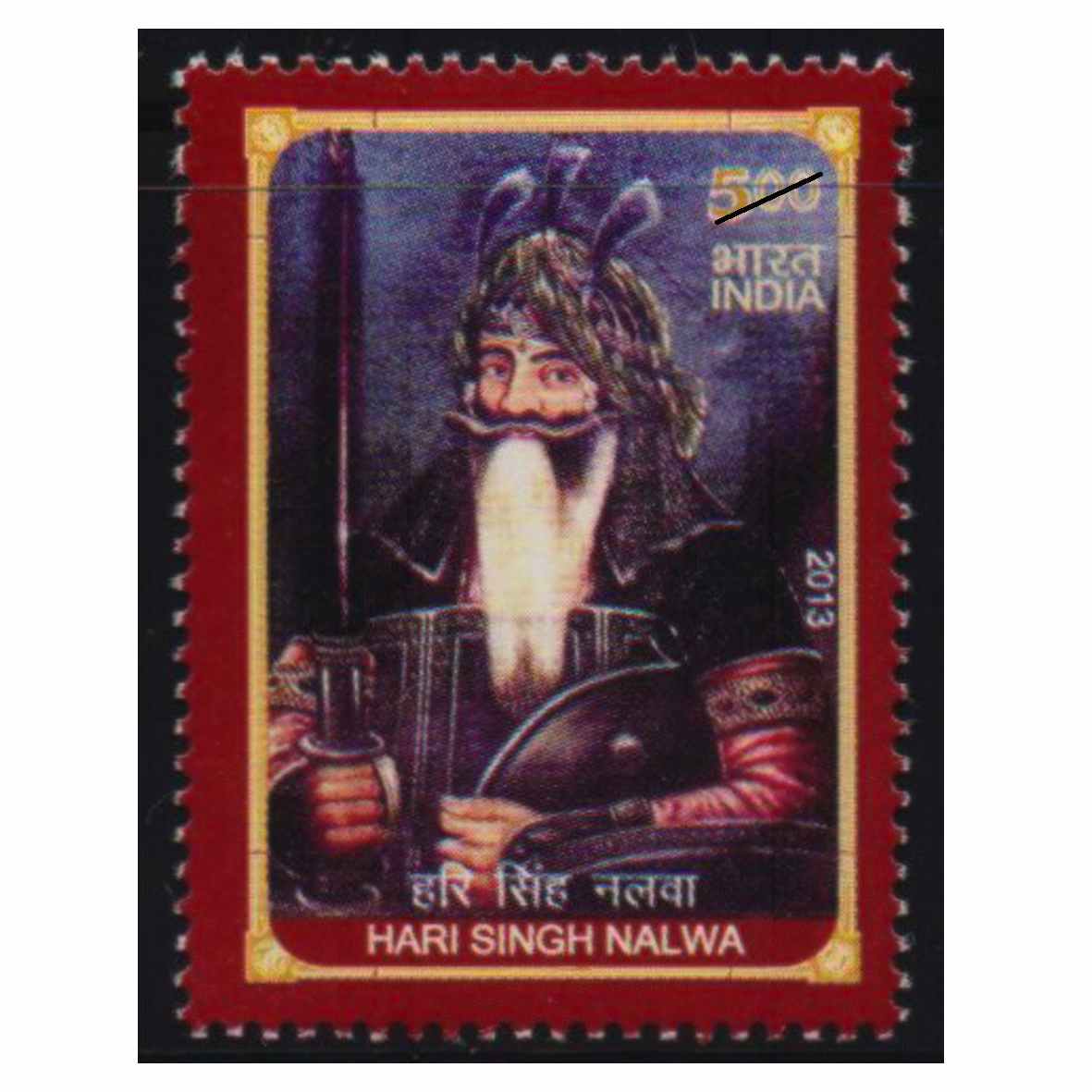
- A great number of books have been published; based on the belligerent life of Nalwa such as Hari Singh Nalwa: Khalsa Ji Da Champion (1791-1837), Sikh Warrior- Hari Singh Nalwa, Hari Singh Nalwa, and many more.
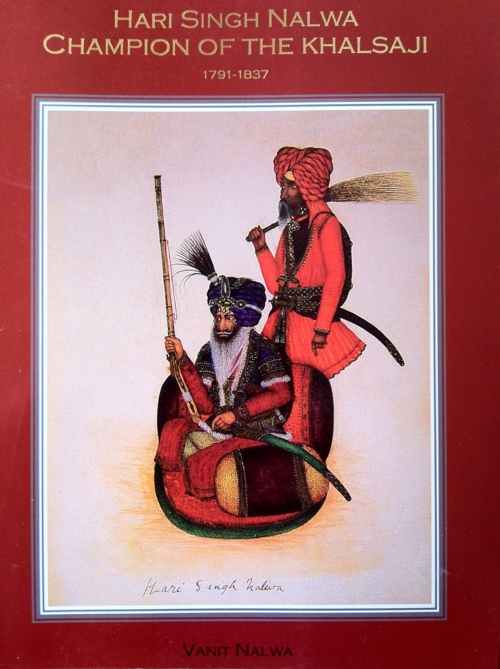
- Punjabi singer Sidhu Moose Wala made a song about Hari Singh Nalwa called “Vaar.” It was released on 8 November 2022, to celebrate the 553rd birthday of Guru Nanak Dev Ji. This song was Sidhu’s second release after his passing, and it quickly gained popularity with 1.5 million views on YouTube in the first 30 minutes.
- In 2018, a 3-D movie named, Jarnayl- Hari Singh Nalwa, was released, which was said to be based on the journey of his life.
- In September 2023, the official sweaters of the Dallas Cowboys football team featured an image of Hari Singh Nalwa as part of the “Carpe Omnia” theme for the upcoming sports season, symbolizing “seize everything.”

